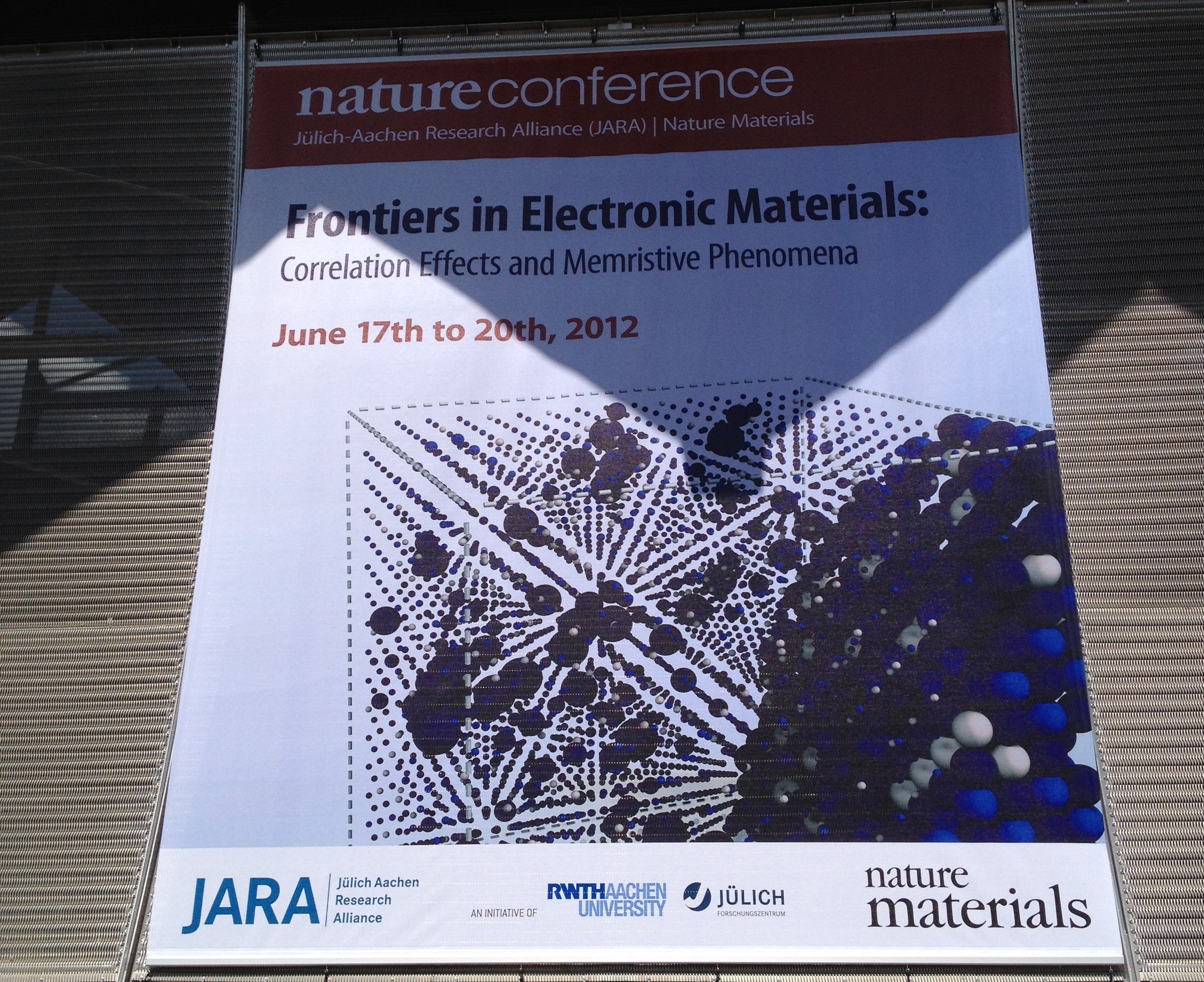 For the past weeks this blog has been more quiet than usual. Mostly, I was busy with a number of projects, including the co-organisation of a Nature Conference – ‘Frontiers in Electronic Materials: Correlation Effects and Memristive Phenomena‘. The conference took place in Aachen/Germany, and was organized in collaboration with the Jülich-Aachen Research Alliance (JARA) formed by the RWTH Aachen University and the Helmholtz research centre in Jülich – who did a great job in getting this meeting off the ground. Rainer Waser in particular dedicated a tremendous amount of work to the conference. And with close to 600 attendees, the popularity of the conference certainly exceeded all our expectations.
For the past weeks this blog has been more quiet than usual. Mostly, I was busy with a number of projects, including the co-organisation of a Nature Conference – ‘Frontiers in Electronic Materials: Correlation Effects and Memristive Phenomena‘. The conference took place in Aachen/Germany, and was organized in collaboration with the Jülich-Aachen Research Alliance (JARA) formed by the RWTH Aachen University and the Helmholtz research centre in Jülich – who did a great job in getting this meeting off the ground. Rainer Waser in particular dedicated a tremendous amount of work to the conference. And with close to 600 attendees, the popularity of the conference certainly exceeded all our expectations.
I do not intend to summarize all the interesting talks at the conference here. Instead, I like to focus on two aspects that I think contributed in particular to the success of the conference, and that could be of interest also to those that couldn’t attend the meeting. They’re related to the scope of the conference and its organisation. […]
Continue reading...

Hong Kong’s airport. Photo by “countries in colors” via flickr.
Conferences are a crucial part of science, because they offer scientists a platform to discuss their latest research results, exchange ideas for future research, and initiate scientific collaborations.
The benefit to attending conferences, along with reduced travel costs, has led to an ever increasing amount of travelling, with sometimes crazy implications. At a large international conference in Singapore earlier this year I met a European researcher who flew in for one day only. And so did a colleague of his from Japan. Another researcher once told me he travels to 27 meetings a year, which is perhaps not even that unusual. Such trips may not be limited to conferences, administrative trips can be even more frequent. Some Chinese professors fly from the provinces to Beijing for grant reviews and other administrative business about every two weeks, if not more often. I suppose it is the same elsewhere, although Japanese and European researchers have the advantage that in most cases they can use trains.
Of course, these are just personal anecdotes. So let’s consider the travelling involved for a larger international conference attended by about 5,000 researchers, as they exist for pretty much all major research fields. Let’s further assume that on average the participants live about 2,500 kilometres (1,500 miles) away from the conference. That’s 25 million kilometres flown in total. An airplane uses about 3 litres of fuel to fly a passenger for 100 kilometres. This means that 750,000 litres of fuel (200,000 US gallons) will be consumed to fly researchers to the conference alone. To move those 750,000 litres around by the way would require about 30 large tank trucks. And in terms of CO2 emissions, well, it’s an estimated 2825 tons. […]
Continue reading...
 For the past weeks this blog has been more quiet than usual. Mostly, I was busy with a number of projects, including the co-organisation of a Nature Conference – ‘Frontiers in Electronic Materials: Correlation Effects and Memristive Phenomena‘. The conference took place in Aachen/Germany, and was organized in collaboration with the Jülich-Aachen Research Alliance (JARA) formed by the RWTH Aachen University and the Helmholtz research centre in Jülich – who did a great job in getting this meeting off the ground. Rainer Waser in particular dedicated a tremendous amount of work to the conference. And with close to 600 attendees, the popularity of the conference certainly exceeded all our expectations.
For the past weeks this blog has been more quiet than usual. Mostly, I was busy with a number of projects, including the co-organisation of a Nature Conference – ‘Frontiers in Electronic Materials: Correlation Effects and Memristive Phenomena‘. The conference took place in Aachen/Germany, and was organized in collaboration with the Jülich-Aachen Research Alliance (JARA) formed by the RWTH Aachen University and the Helmholtz research centre in Jülich – who did a great job in getting this meeting off the ground. Rainer Waser in particular dedicated a tremendous amount of work to the conference. And with close to 600 attendees, the popularity of the conference certainly exceeded all our expectations.


June 27, 2012
2 Comments